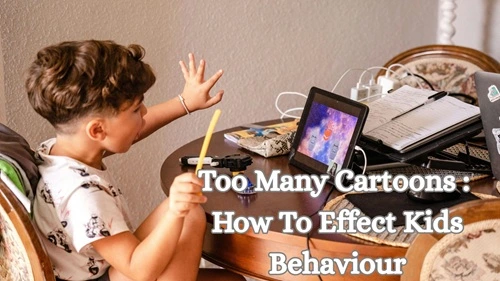Cartoons have always been a magical part of childhood. From Tom and Jerry to today’s animated superheroes, they bring laughter, imagination, and joy. But as parents, a big question arises, what happens when cartoons stop being entertainment and start becoming an addiction?
With mobile phones, smart TVs, and streaming apps, cartoons are available 24/7, and many children spend hours glued to the screen. While a little cartoon time can be fun and even educational, too much exposure can impact a child’s brain, emotions, and behavior in ways parents may not realize.
In this blog, we’ll explore how excessive cartoon watching affects children’s mental growth, emotional balance, and social behavior and what parents can do to create a healthy balance.

Why Children Love Cartoons So Much
Before we dive into the effects, it’s important to understand why kids are so attracted to cartoons:
- Bright colors and sounds stimulate their senses.
- Funny characters and stories capture their imagination.
- Fast-paced action keeps them engaged.
- Catchy songs or dialogues make them remember and repeat.
In moderation, this is harmless. But when cartoons become the only source of entertainment, they can interfere with real world experiences.
The Negative Effects of Watching Too Many Cartoons
1. Shortened Attention Span
Modern cartoons are fast paced, with quick scene changes and exaggerated actions. While entertaining, this can make it harder for kids to focus on slower, real life activities like reading, studying, or listening to instructions.
2. Aggressive or Imitative Behavior
Not all cartoons are peaceful. Many show fights, pranks, or rude behavior in a funny way. Children, especially under 8 years old, struggle to differentiate between real and pretend. As a result, they may:
- Copy fights or arguments.
- Use cartoon style dialogues in daily life.
- Think aggression is a normal way to solve problems.
3. Reduced Physical Activity
Long hours of sitting in front of a screen limit a child’s movement. Over time, this may lead to:
- Lack of interest in outdoor games.
- Risk of obesity.
- Lower stamina and poor posture.
4. Language and Communication Issues
Some cartoons use slang, made-up words, or broken language. When kids imitate these, their communication skills may suffer. Instead of learning correct grammar or polite ways to speak, they may copy cartoonish expressions.
5. Sleep Problems
Bright screens and stimulating visuals, especially before bedtime, can disturb a child’s sleep pattern. Poor sleep affects mood, concentration, and academic performance.
6. Distorted View of Reality
Cartoons often exaggerate characters, animals that talk, humans with superpowers, or unrealistic problem solving. While imagination is good, too much of it can blur a child’s understanding of real world situations.
7. Emotional Sensitivity
Some kids get overly attached to characters. They may cry if a favorite hero loses or feel anxious if a villain appears. This emotional rollercoaster can make them more irritable in daily life.
The Positive Side (When Watched in Moderation)
It’s not all bad news! Cartoons, if chosen wisely, can have positive effects too:
- Educational cartoons can improve vocabulary and general knowledge
- Some shows teach moral lessons like kindness, teamwork, and honesty
- They boost imagination and creativity
- Bilingual or language learning cartoons can help kids pick up new words
So, the goal is balance, not complete restriction.
How Much is Too Much?
According to child development experts:
- For kids under 2 years: Avoid screen time as much as possible
- For ages 2–5 years: No more than 1 hour of high-quality screen time per day
- For ages 6 and above: Screen time should be balanced with physical activity, studies, and family interaction
Practical Tips for Parents
Here are some actionable steps to manage your child’s cartoon watching habits:
- Set Screen-Time Limits – Fix a schedule (e.g., 30 minutes after homework)
- Choose the Right Cartoons – Opt for shows that teach values, creativity, or problem-solving
- Co-View with Your Child – Watch together and explain the difference between real and pretend
- Encourage Outdoor Play – Involve them in sports, cycling, or creative hobbies
- Introduce Alternatives – Books, puzzles, drawing, or storytelling sessions can replace screen time
- Avoid Screen Before Bedtime – Replace with calming activities like reading a bedtime story
Please read : How to Reduce Screen Time For Kids
Final Thoughts
Cartoons are not the enemy, they are a part of childhood joy. But like sweets, too much of them can harm a child’s growth and behavior. As parents, it’s about striking the right balance between entertainment and real-world experiences.
Encourage your child to laugh with their favorite characters but also to run, play, read, and interact with the world around them. After all, the best memories are made outside the screen.

Hi, I’m Prashant Jain — a curious soul, storyteller, and content creator at heart.I’ve always been drawn to the world of entertainment, travel, sports, health & lifestyle — not just as a writer, but as someone who genuinely lives these experiences. Whether I’m binge-watching the latest OTT series, exploring offbeat spiritual destinations in India, or diving deep into wellness routines and cricket match insights, I love sharing what I discover with like-minded readers.
PopNewsBlend is my way of blending personal journeys with meaningful stories — ones that inform, inspire, and keep you ahead of the curve. Everything I write comes from real observations, hands-on experiences, and a deep passion for understanding the world around us.
Discover more from Popnewsblend
Subscribe to get the latest posts sent to your email.







